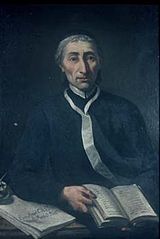Eusebius Amort

( oil painting from the picture gallery of the Bavarian Academy of Sciences , Photo: BAdW)
Eusebius Amort (born November 15, 1692 on the beaver mill near Tölz as Thomas Amort , † February 5, 1775 in Polling (Upper Bavaria)) was a Catholic theologian .
Life
After graduating from high school in 1708 at the Jesuit high school in Munich (today Wilhelmsgymnasium Munich ), Amort joined the Polling monastery of the Augustinian Canons in 1709 . From 1717 he taught philosophy, theology and canon law there. In 1720 Amort became a co-founder of the learned society Der Bavarian Musenberg . In the first years of his teaching activity, he was occupied with astronomy , which thematically revolved primarily around the validity of the Copernican doctrine.
From 1733 to 1735 Eusebius Amort stayed to study in Rome, which resulted in a lively correspondence with Pope Benedict XIV , many scholars and cardinals . In 1759 he became a founding member of the Bavarian Academy of Sciences . Amort was educated in many ways and was a respected scientist, especially in moral theology and canon law. Of his more than 70 works, many are only preserved in handwritten form in the Bavarian State Library .
Amort achieved particular fame in the dispute over the authenticity of the private revelations of María von Ágreda , which he was extremely critical of. He described her private revelations as "doubtful" and her posthumously published work Mistica Ciudad de Dios ( Mystical City of God ) as " apocryphal ". He tried to show shortcomings in the private revelations and the strong influence of Maria Ágreda's imagination. However, he never denied the personal sanctity of Mary of Ágreda.
After intensive study of the church fathers, saints (especially well-known mystics) and theologians, he drew up 125 rules about the distinction between real and false private revelations, some of which are, however, too strict. His teaching on the private revelations was at the latest with the research Prosper Lambertinis, the future Pope Benedict XIV. In De beatificatione et canonizatione servorum Dei outdated, but provided the impetus for the later usual inclusion of medicine, humanities, natural sciences, etc. in the assessment of Private revelations .
Amort further proved by intensive study of the sources that the Imitation of Christ ( Imitation of Christ ) by Thomas a Kempis and not by John Gerson came. In moral theology he took a middle position between the rigorists and the probabilists and thus became the founder of equiprobabilism with Alfonso Maria de Liguori .
Works
- Nova Philosophiae Planetarum et Artis Criticae Systemata Adumbrata. 1723.
- Philosophia Pollingana ad normam Burgundicae. 1730.
- De origine, progressu, valore ac fructu Indulgentiarum. 1735.
- De Revelationibus, Visionibus et Apparationibus Privatis Regulæ ... 1744.
- Controversia de Revelationibus Agredanis. 1749.
- Nova Demonstratio de falsitate Revelationum Agredanarum ... 1751.
- Theologia eclectica moralis et scholastica. 4 volumes Würzburg 1752.
- Theologia moralis inter rigorem et laxitatem media. Augsburg 1757.
- Elementa iuris canonici. 3 volumes 1757.
- Three essays on librarianship, published anonymously from 1726–1727 in Parnassus Boicus: 1. From which libraries or libraries in common. 2. The order and organization of the libraries. 3. From the libraries of Bayrland.
- Contributions in and supplements to: Non-profit consideration of the latest writings, which relate to religion ~ customs and the reform of the human race. In connection with a society of scholars. Ed. GF Seiler, Erlangen 1776–1800.
- Contributions to ecclesiastical history of the 18th century: from the handwritten estate of the regul. Canon Eusebius Amort / add. by J. Friedrich . Munich: Verlag der k. Academy, in Comm. in G. Franz, 1876.
literature
- Alice Arnold: Eusebius Amort . In: Jürgen Wurst and Alexander Langheiter (eds.): Monachia. Städtische Galerie im Lenbachhaus, Munich 2005, p. 85, ISBN 3-88645-156-9 .
- Friedrich Wilhelm Bautz : Amort, Eusebius. In: Biographisch-Bibliographisches Kirchenlexikon (BBKL). Volume 1, Bautz, Hamm 1975. 2nd, unchanged edition Hamm 1990, ISBN 3-88309-013-1 , Sp. 150.
- Karin Precht-Nussbaum: Between Augsburg and Rome. The Augustinian canon of Pollingen, Eusebius Amort (1692–1775). An important representative of the Catholic Enlightenment in Bavaria. Paring 2007.
- Gustav Schnürer. Catholic Church and Culture in the 18th Century. 1941, p. 241 ff.
- Georg Rückert : Eusebius Amort and the Bavarian intellectual life in the 18th century. (Edited by Josef Schöttl), 1956.
- Otto Schaffner: Eusebius Amort (1692–1775) as a moral theologian. Paderborn 1964.
- Otto Schaffner: Eusebius Amort (November 15, 1692 - February 5, 1775) (In: Bavaria sancta. Ed. By Georg Schwaiger, Volume 3, pp. 373-387, Regensburg 1973).
- Franz Xaver Seppelt : Amort, Eusebius. In: New German Biography (NDB). Volume 1, Duncker & Humblot, Berlin 1953, ISBN 3-428-00182-6 , p. 256 f. ( Digitized version ).
- Entry in the Catholic Encyclopedia , Robert Appleton Company, New York 1913.
- DHGE II, 1332 f.
- LThK I, 446 f.
Web links
Individual evidence
- ^ Max Leitschuh: The matriculations of the upper classes of the Wilhelmsgymnasium in Munich , 4 vol., Munich 1970–1976; Vol. 2, p. 145.
| personal data | |
|---|---|
| SURNAME | Amort, Eusebius |
| ALTERNATIVE NAMES | Amort, Thomas (original name) |
| BRIEF DESCRIPTION | German Catholic theologian |
| DATE OF BIRTH | November 15, 1692 |
| PLACE OF BIRTH | Toelz |
| DATE OF DEATH | February 5, 1775 |
| Place of death | Polling , Upper Bavaria |